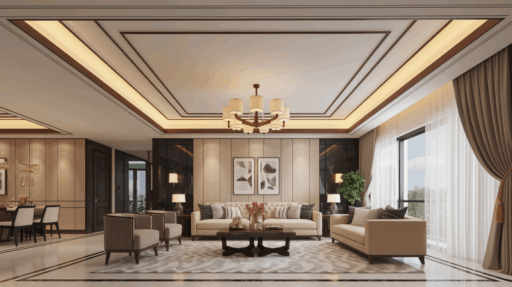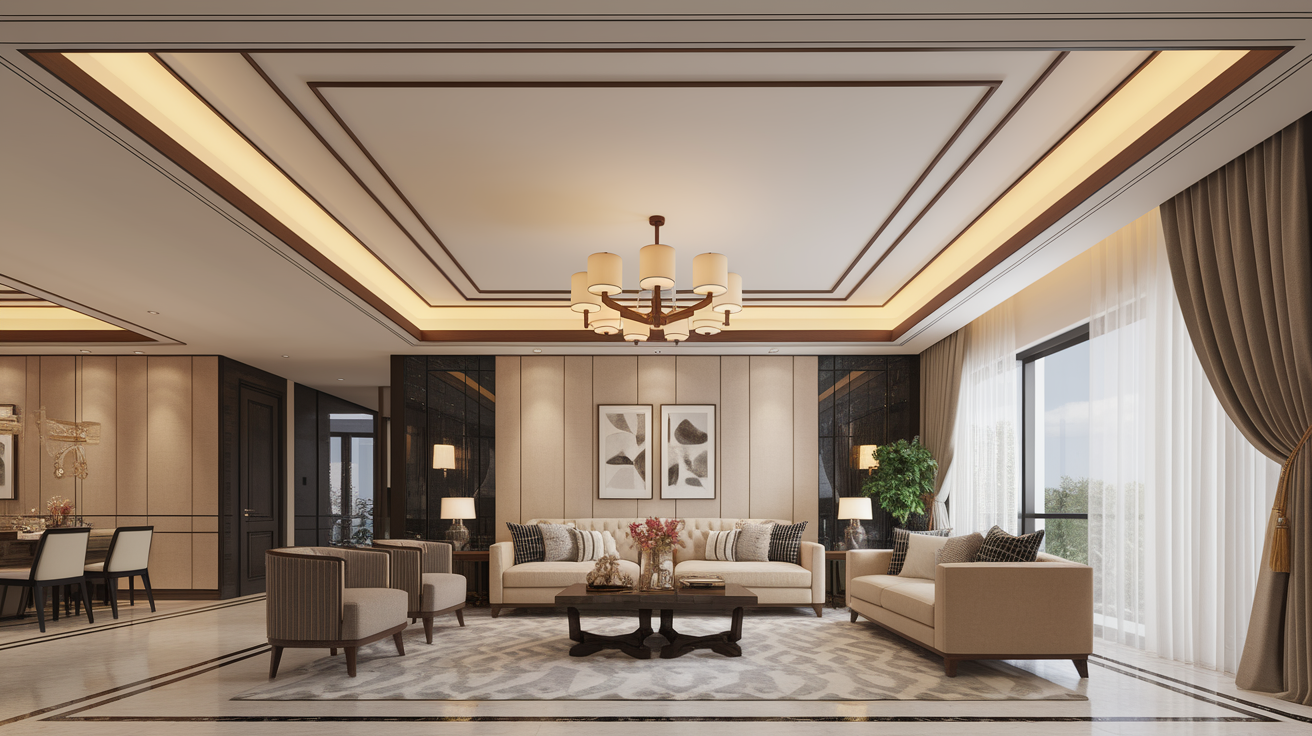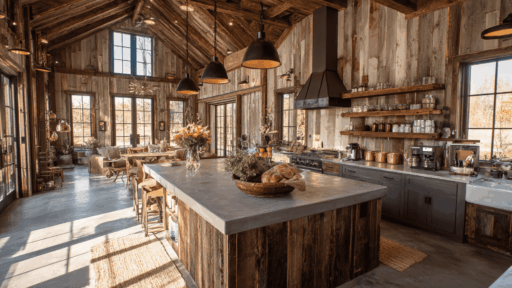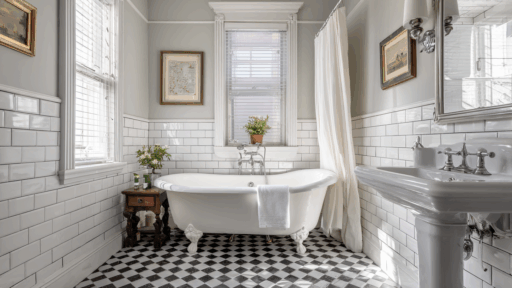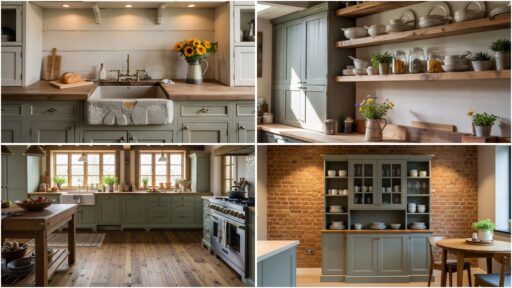What if the most impactful design element in your home is the one you never look at?
Ceilings shape how rooms look and feel, yet they’re often overlooked in design. The right choice can make spaces appear larger, brighter, or more intimate.
Beyond aesthetics, ceilings offer practical benefits like improved acoustics and lighting. They significantly impact the overall comfort and functionality of your living spaces.
This guide examines different types of ceilings for homeowners, designers, and renovators. We’ll cover essential ceiling types to help you make informed decisions for your projects.
From flat surfaces to textured finishes and structural features, understanding these types of ceilings helps you choose options that match your style and budget.
Why Ceiling Design Matters in Interior Decor
Ceilings shape how a room feels by influencing light, sound, and space. Their height and form can make a room feel more open or more contained, depending on the layout.
They also play a role in comfort. Some ceiling types support better insulation, reduce noise, and assist with airflow. In open layouts, ceiling changes can help divide space without using walls.
Visually, ceilings complete the overall setting. Whether flat, detailed, or textured, they bring balance to the space and connect elements like furniture, flooring, and lighting.
When updated with features like tray insets, beam accents, or built-in lights, ceilings often stand out during resale. These upgrades reflect style, attention to design, and lasting quality.
More than just a surface above, the ceiling supports both how a room works and how it feels.
Types Of Ceilings
Ceilings vary in shape and form, each bringing a different effect to a room. Some add height or texture, while others support a clean, simple finish. The list below outlines common ceiling styles and how they affect interior spaces.
1. Flat Ceilings
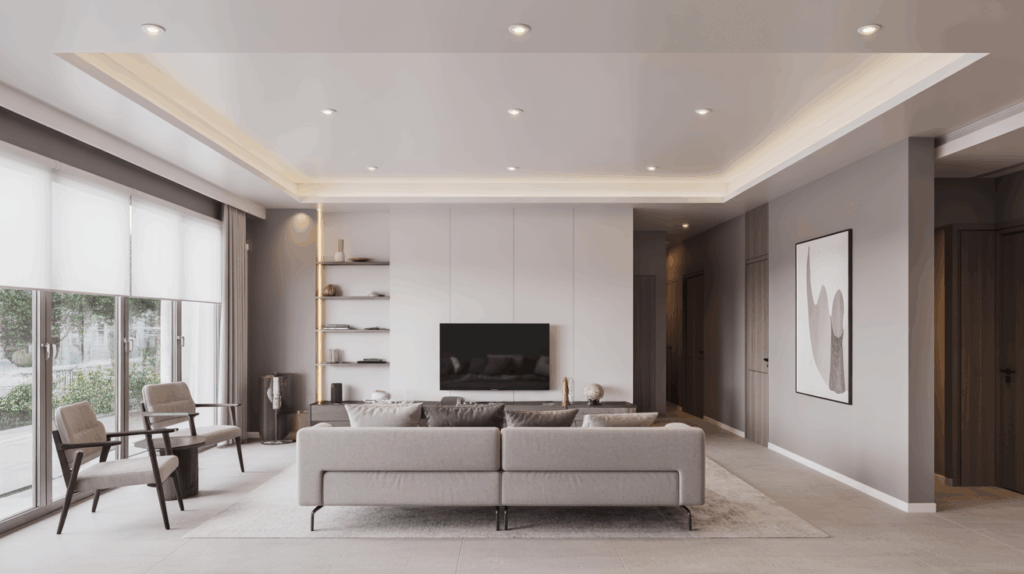
Flat ceilings are the most common home option, providing clean backdrops for any interior style. These budget-friendly installations offer quick construction, minimal materials, and work with all decor themes.
Why Flat Ceilings Work So Well
- Quick to build – Minimal framing means shorter timelines
- Budget-friendly – Fewer materials and faster labor reduce costs
- Design-neutral – Works with both classic and modern interiors
- Low maintenance – No curves or recesses to clean or repair
Best Spaces for Flat Ceilings These ceilings work well in bedrooms for tranquil relaxation, living rooms for smooth lighting, kitchens for unobstructed headroom, and hallways for visual continuity.
Style Enhancement Tips Add crown molding, contrast paint, or statement lighting without structural changes to maintain clean appearance while adding visual interest.
2. Tray Ceilings

Tray ceilings feature a raised central panel surrounded by lower borders, creating visual interest in rooms. These installations add depth without major structural changes while making spaces feel taller.
Why Tray Ceilings Work So Well
- Visual interest – Multi-level design adds depth without complexity
- Space enhancement – Raised center makes rooms feel larger
- Lighting flexibility – Perimeter and center lighting options
- Cost-effective – Reasonable installation without complex framing
Best Spaces for Tray Ceilings. These ceilings work well in dining rooms for formality and master bedrooms for refinement.
Style Enhancement Tips Add crown molding, accent paint, or decorative lighting around perimeters or center sections.
3. Coffered Ceilings
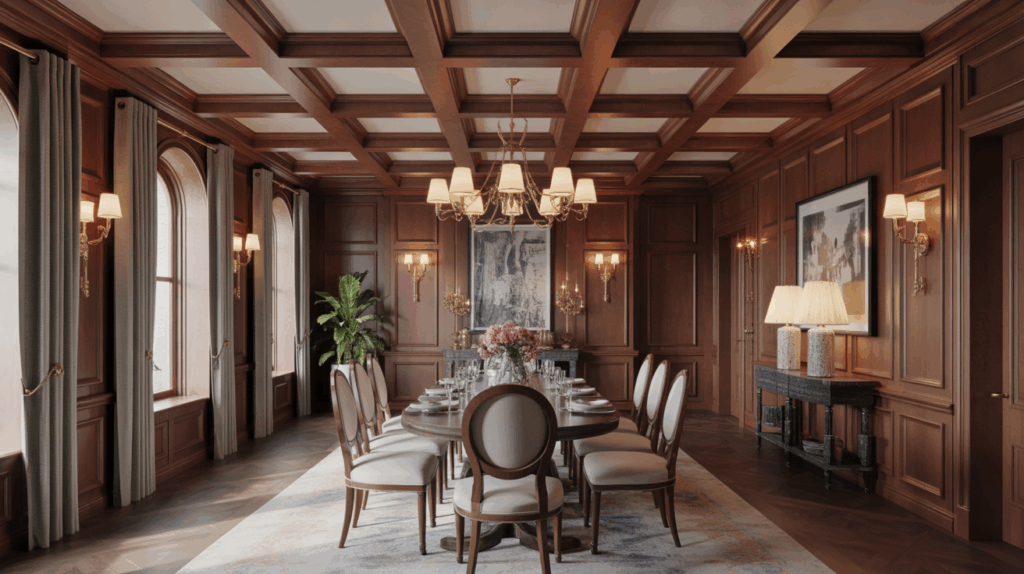
Coffered ceilings feature a grid-like pattern with intersecting beams or recessed panels, bringing classical appeal to spaces. These installations add visual richness in formal living rooms, libraries, and studies.
Why Coffered Ceilings Work So Well
- Classical appeal – Grid pattern brings lasting luxury
- Visual richness – Geometric design adds structural weight
- Style versatility – Suits traditional or transitional designs
- Value addition – Investment increases home value
Best Spaces for Coffered Ceilings. These ceilings work best in formal rooms with higher ceiling heights for proper proportions.
Style Enhancement Tips Ensure adequate room height and skilled craftsmanship for balanced proportions.
4. Vaulted Ceilings

Vaulted ceilings feature sloped surfaces that rise to a peak, creating spaciousness in rooms. These installations maximize vertical space and natural light in rustic, farmhouse, or cathedral-style homes.
Why Vaulted Ceilings Work So Well
- Spacious feel – Upward design creates openness
- Natural light – Angled structure maximizes window space
- Dramatic impact – Height makes rooms feel larger
- Style versatility – Suits rustic, farmhouse, or cathedral designs
Best Spaces for Vaulted Ceilings. These ceilings work well in living rooms, great rooms, and master bedrooms.
Style Enhancement Tips Consider statement lighting fixtures and tall windows to maximize vertical space
5. Cathedral Ceilings

Cathedral ceilings feature symmetrical sloping sides that follow the roofline, creating impressive height with structural simplicity.
Why Cathedral Ceilings Work So Well
- Impressive height – Symmetrical slopes create striking vertical space
- Cost-effective – Follows existing roof structure with minimal modifications
- Natural warmth – Exposed beams add visual interest
- Style flexibility – Suits rustic, contemporary, or transitional designs
Best Spaces for Cathedral Ceiling.s These ceilings work well in living rooms, great rooms, and master suites.
Style Enhancement Tips Incorporate exposed beams or natural wood elements to add warmth to large spaces.
6. Beamed Ceilings
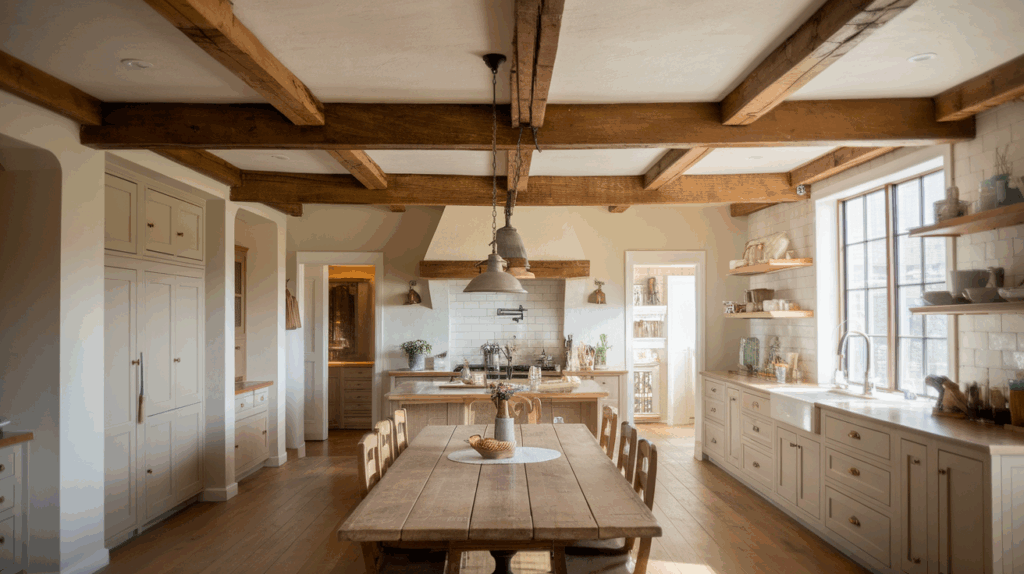
Beamed ceilings feature exposed wooden or faux beams that create rustic or industrial appeal, adding visual weight and character to rooms.
Why Beamed Ceilings Work So Well
- Visual character – Exposed beams add weight and personality
- Warmth factor – Natural wood brings an inviting texture
- Style versatility – Suits farmhouse, rustic, industrial, or transitional designs
- Installation options – Real reclaimed wood or lightweight faux alternatives
Best Spaces for Beamed Ceilings. These ceilings work well in kitchens, dining rooms, and living areas.
Style Enhancement Tips Choose real reclaimed wood for authenticity or lightweight faux alternatives based on budget and structural capacity.
7. Cove Ceilings
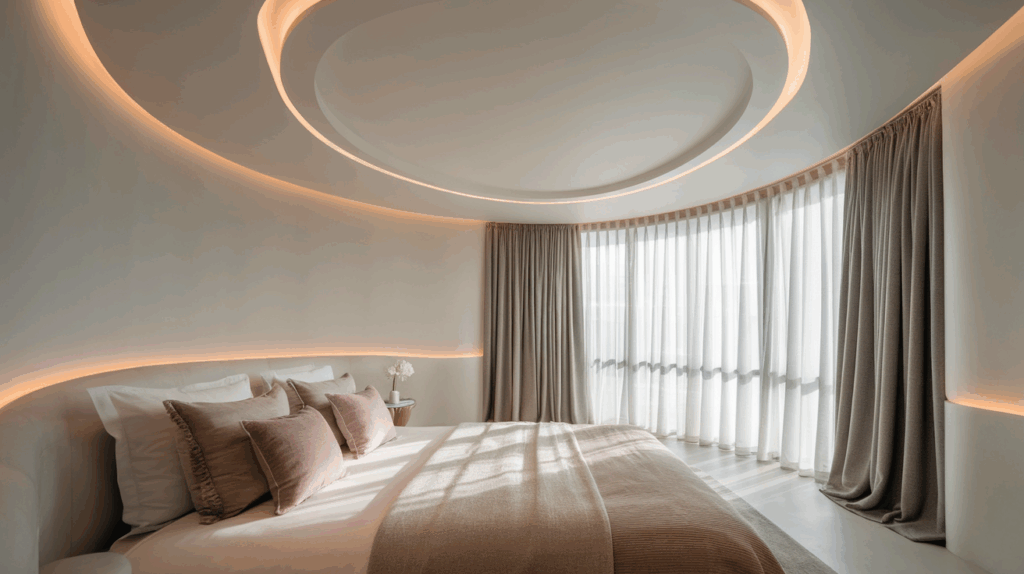
Cove ceilings feature rounded transitions between walls and ceilings instead of sharp angles, creating a flowing appearance that softens room edges.
Why Cove Ceilings Work So Well
- Soft appearance – Curved design creates flowing, gentle room transitions
- Lighting integration – Ideal for hidden LED strips and ambient illumination
- Calming effect – Adds subtle refinement to create relaxing atmospheres
- Visual enhancement – Smooth curves enhance comfort and visual interest
Best Spaces for Cove Ceiling.s These ceilings work well in bedrooms, living rooms, and dining areas where calm, relaxing atmospheres are desired.
Style Enhancement Tips Install hidden LED strips along curved sections to wash walls with soft illumination.
8. Barrel Vault Ceilings
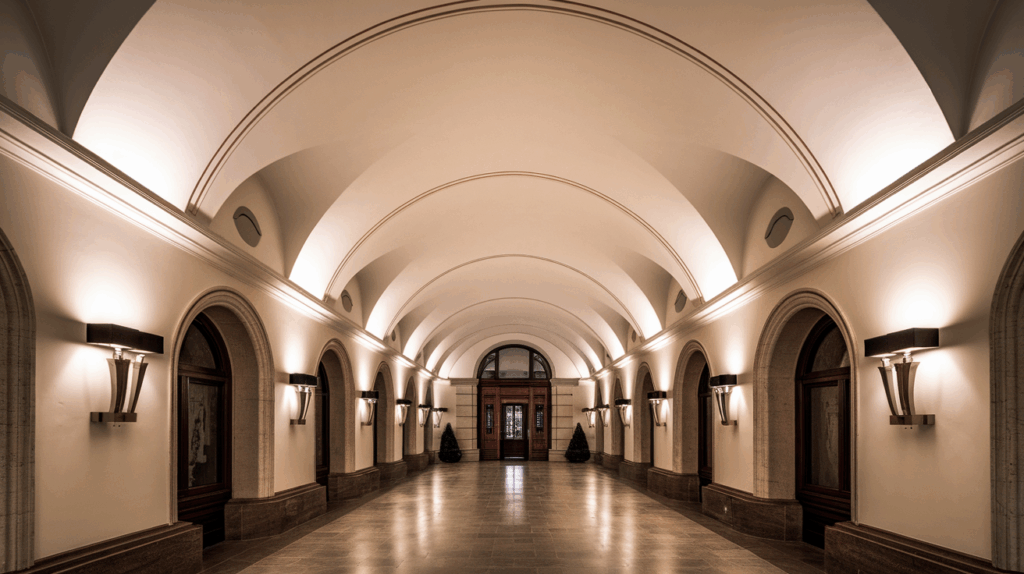
Barrel vault ceilings feature a semi-cylindrical curve spanning the room length, creating an impressive visual impact with historic structural significance.
Why Barrel Vault Ceilings Work So Well
- Classical appeal – Reminiscent of Roman and medieval structure
- Visual impact – Continuous curve draws eyes along the room length
- Height addition – Adds substantial vertical space
- Focal point – Creates a striking structural centerpiece
Best Spaces for Barrel Vault Ceilings. These ceilings suit long hallways, entrances, or gallery spaces in traditional or classical themes.
Style Enhancement Tips Ensure proper structural support and specialized construction techniques for safe, striking results.
9. Dome Ceilings
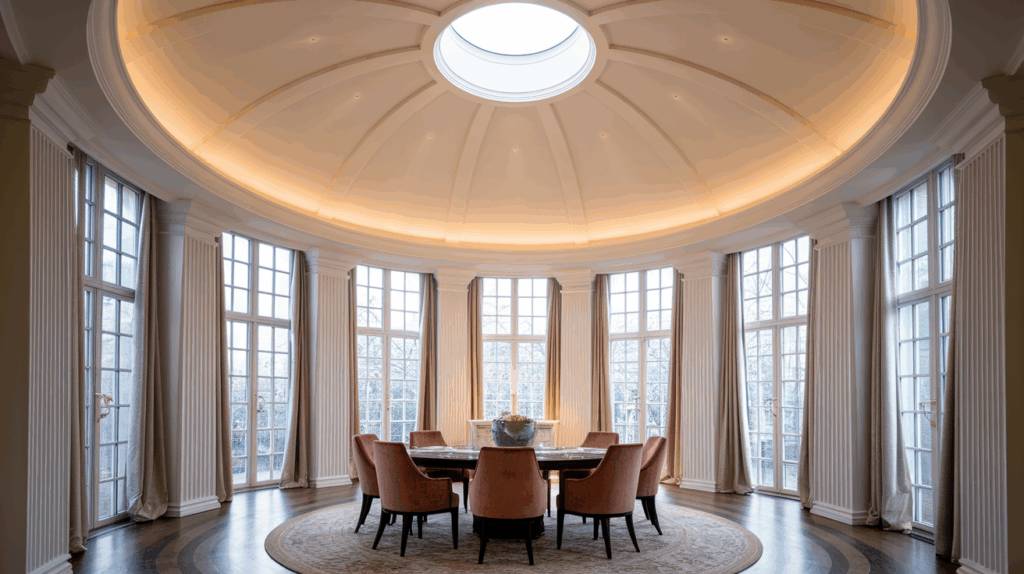
Dome ceilings feature rounded, spherical structures that curve upward from all sides, adding grandeur as a natural focal point.
Why Dome Ceilings Work So Well
- Impressive height – Creates substantial vertical space
- Attention-drawing – Natural focal point for the room centers
- Excellent acoustics – Curved surface provides superior sound distribution
- Even lighting – Distributes light evenly throughout areas
Best Spaces for Dome Ceilings. These ceilings work well in lobbies, entryways, rotundas, and formal dining rooms.
Style Enhancement Tips Ensure specialized engineering and construction expertise for proper structural support.
10. Suspended or Drop Ceilings
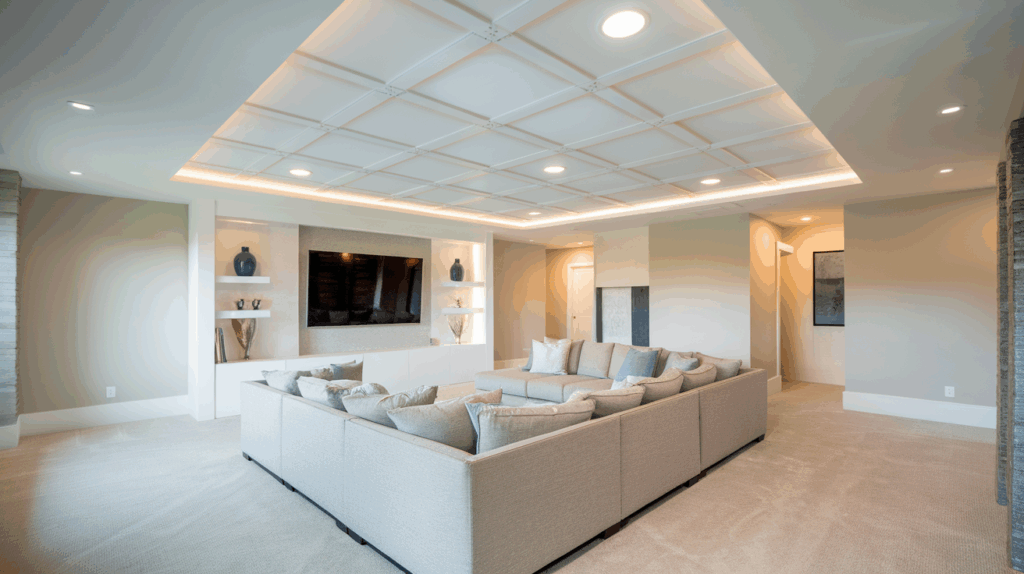
Suspended or drop ceilings feature a secondary ceiling below the structural ceiling, using a grid framework to support lightweight tiles or panels.
Why Suspended Ceilings Work So Well
- Functional priority – Common in basements, offices, and commercial spaces
- Easy access – Provides utility access while maintaining a finished appearance
- System concealment – Hides wiring, ducts, and mechanical systems
- Cost-effective – Straightforward installation compared to other types
Best Spaces for Suspended Ceilings. These ceilings work well in basements, offices, and commercial spaces.
Style Enhancement Tips Use modular system for easy panel replacement and lighting fixture integration.
11. Shed Ceilings
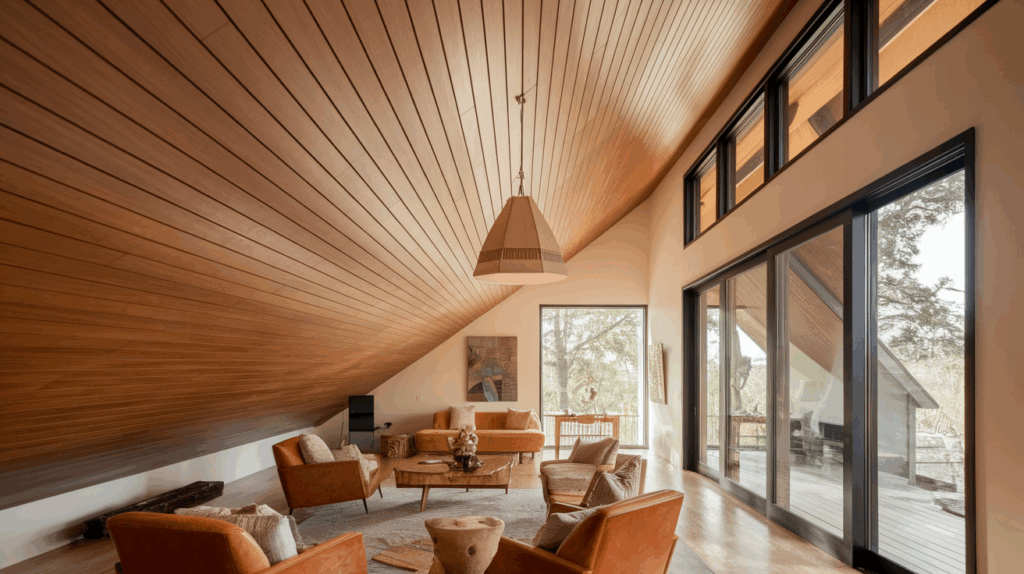
Shed ceilings feature a single-sloped surface that angles from one wall to another, creating modern appeal in contemporary spaces.
Why Shed Ceilings Work So Well
- Modern appeal – Simple geometric form creates a contemporary look
- Height maximization – Single slope maximizes height on one side
- Visual interest – Creates interesting visual lines and spatial flow
- Straightforward construction – Follows roofline structure for easy installation
Best Spaces for Shed Ceilings. These ceilings work well in lofts, open-plan homes, and modern additions where contemporary style matters.
Style Enhancement Tips Use angled surface for interesting lighting and window configurations to emphasize particular areas or views.
12. Custom or Textured Ceilings

Custom and textured ceilings include popcorn, knockdown, and orange peel textures that add visual interest and hide minor imperfections.
Why Custom/Textured Ceilings Work So Well
- Visual interest – Surface treatments add texture and dimension
- Imperfection hiding – Textures conceal minor ceiling flaws
- Personal expression – Allow homeowners to create unique features
- Style flexibility – Complement various decor themes
Best Spaces for Custom/Textured Ceilings. These ceilings work well in bedrooms, dining rooms, or accent areas.
Style Enhancement Tips Choose from spray textures, hand-applied techniques, artistic paint, wallpaper, or 3D panels based on room function and maintenance preferences.
Choosing the Right Ceiling Type
Selecting a ceiling involves more than style alone. Room size, ceiling height, and overall layout play a key role in how well a ceiling design will perform and look.
Before making a decision, take a moment to think about how the ceiling will interact with the rest of the space.
Ceiling height: Tall ceilings work well with vaulted or coffered styles. Standard heights suit flat or tray ceilings.
Room scale: Large rooms can handle layered designs. Compact rooms often feel better with clean, simple finishes.
Lighting and airflow: Choose a ceiling style that supports both light placement and ventilation.
Cost and effort: Some designs need more materials and time. Keep structural limits and finish level in mind.
Maintenance needs: Smooth ceilings are easier to clean. Textures may hide flaws, but could need more upkeep.
A well-chosen ceiling can improve how a room performs and how it feels. Take time to evaluate both form and function to ensure the ceiling supports your space effectively.
Ceiling Materials and Finishes Overview
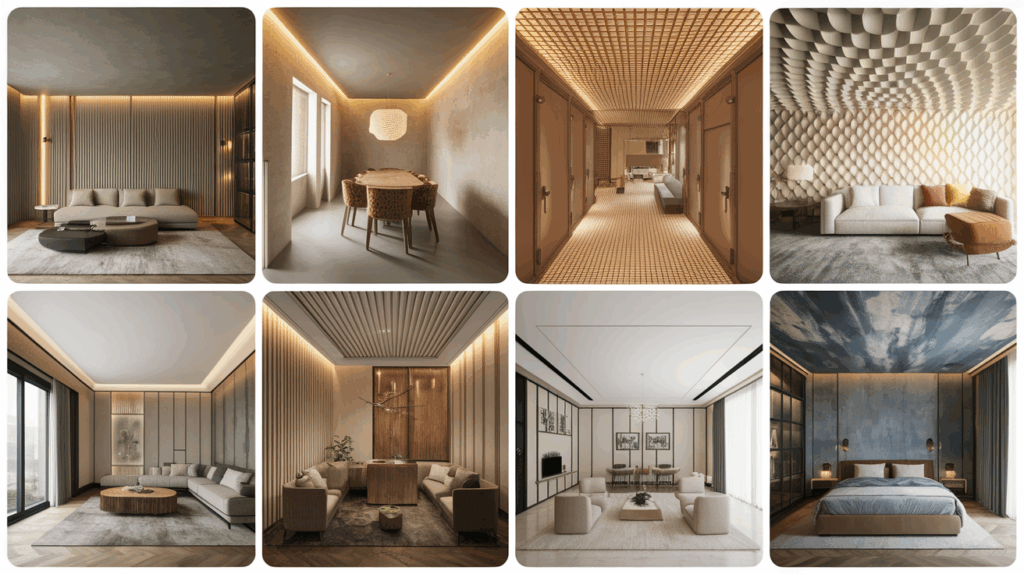
Selecting the right ceiling material impacts both aesthetics and functionality in your home. Here’s a comparison of popular ceiling materials and their key characteristics.
| Material | Key Features | Best Uses |
|---|---|---|
| Drywall | Smooth surface, paintable, textured options available | Standard residential rooms, cost-effective installations |
| Wood | Natural warmth, various tones and finishes, versatile styling | Casual and formal interiors add character and texture |
| Metal | Clean surface, light-reflective, tin or aluminum options | Traditional or industrial themes, commercial spaces |
| Plaster | Clean lines, custom trim work, and long-lasting durability | Older buildings, classic features, premium finishes |
| PVC Panels | Moisture resistant, easy maintenance, practical installation | Bathrooms, kitchens, laundry rooms, and high-humidity areas |
Each material offers distinct advantages depending on your room’s function, moisture levels, and design preferences. Consider factors like maintenance requirements, installation costs, and long-term durability when making your selection.
Note: Always consult with professionals regarding structural requirements and local building codes before selecting ceiling materials for your project.
Finishing Methods for Ceilings
After selecting a base material, adding a finish can complete the ceiling’s look. Common finishing methods include
- Paint: A simple and flexible choice that works with nearly every ceiling material. Paint allows for easy updates and can match any wall or trim color.
- Stain: Often used with wood, stain brings out the grain and gives the ceiling a richer appearance.
- Wallpaper: Suitable for flat ceilings, wallpaper adds pattern and texture without requiring significant construction changes.
- Paneling: This approach uses fixed boards or tiles to give the ceiling more structure and definition.
Maintenance and Durability Tips
Each ceiling material requires different care levels to maintain appearance and prevent costly repairs.
Low-Maintenance Options: PVC panels require simple cleaning, whereas drywall requires occasional repainting and minor repairs.
Medium-Maintenance Materials: Metal ceilings need regular cleaning and occasional polishing. Plaster requires minimal care with minor crack touch-ups.
Higher-Maintenance Choice Wood ceilings demand proper sealing, regular inspections, and protection against humidity and insects.
Brilliant Strategy: Inspect all materials annually and address minor problems immediately to prevent significant repairs.
Conclusion
Your ceiling choice affects how you experience your home every day. The right option balances your style preferences, practical needs, and budget while working with your existing architecture.
Think about factors like room height, natural light, and maintenance requirements when making your decision. Professional installation ensures proper structure and long-lasting results.
Start by identifying your top priorities, whether that’s maximizing space, reducing energy costs, or creating visual impact.
Then work with experienced contractors to bring your vision to life and improve your rooms from ordinary to exceptional.
Found this helpful? Save this guide for your next home project and share your ceiling renovation ideas in the comments below.

